Table of Contents
Who wouldn’t aspire to achieve strong and shapely thighs and calves? These regions lend contour and volume to our legs. Simultaneously, they play a pivotal role in daily mobility, particularly in walking and maintaining balance. Hence, it’s worthwhile to include these areas in your workout routine.
Calves are often overlooked during workouts, which can lead to disproportionately distributed muscle mass in the legs. Additionally, they serve as the centre of dynamic power for the lower limbs, especially during jumps, running, cycling, or walking up stairs or hills. Strengthening them can enhance your ability to move faster and more efficiently. While genetics certainly play a significant role in their size, it doesn’t mean that strengthening this area is without merit. You may not develop calves like professional bodybuilders, but that’s not the goal, unless you aspire to get the title of Mr. Olympia. When working out, it’s best to combine calf exercises with thigh exercises, which is why we’ve linked them in today’s article.
How to Exercise Thighs and Calves?
While you engage the muscles of the thighs and calves during everyday activities such as running or climbing stairs, they need a substantial stimulus for their growth and strengthening. This is best achieved through well-chosen exercises in the gym using machines, dumbbells, or a barbell. Of course, it is crucial to first learn how to perform the exercises with proper technique and then gradually increase the load as you gain strength over time.
When working on your thighs and calves, you should begin with a warm-up and stretching, like with any other type of workout. This prepares the muscles for the workload and reduces the risk of injury. Just a few minutes spent on a rowing machine, skipping rope, or perhaps doing jumping jacks should suffice. Afterwards, proceed to mobilize your entire body, focusing on the hips, knees, and ankles. Then, move on to the main part of your workout.
You can easily design a workout for your thighs and calves in the gym using the presented exercises. To start, select approximately 2–3 exercises for each muscle group and perform them in 3 working sets with a range of 8–12 repetitions per set. Aim for a load of around 60–75% of your 1 RM (maximum power for 1 repetition). Incorporate thigh and calf workout either independently or in combination with a less demanding muscle group, such as the abdomen, ideally 2–3 times a week. Keep in mind that complete muscle recovery after strength training typically takes around 24–72 hours. Therefore, plan your workouts and the frequency per week for specific muscle groups accordingly. [1–3]
If you’re also interested in a comprehensive guide for shaping your buttocks and legs, including nutritional recommendations, you can find it in the article: How to Tone and Shape Your Butt and Legs.
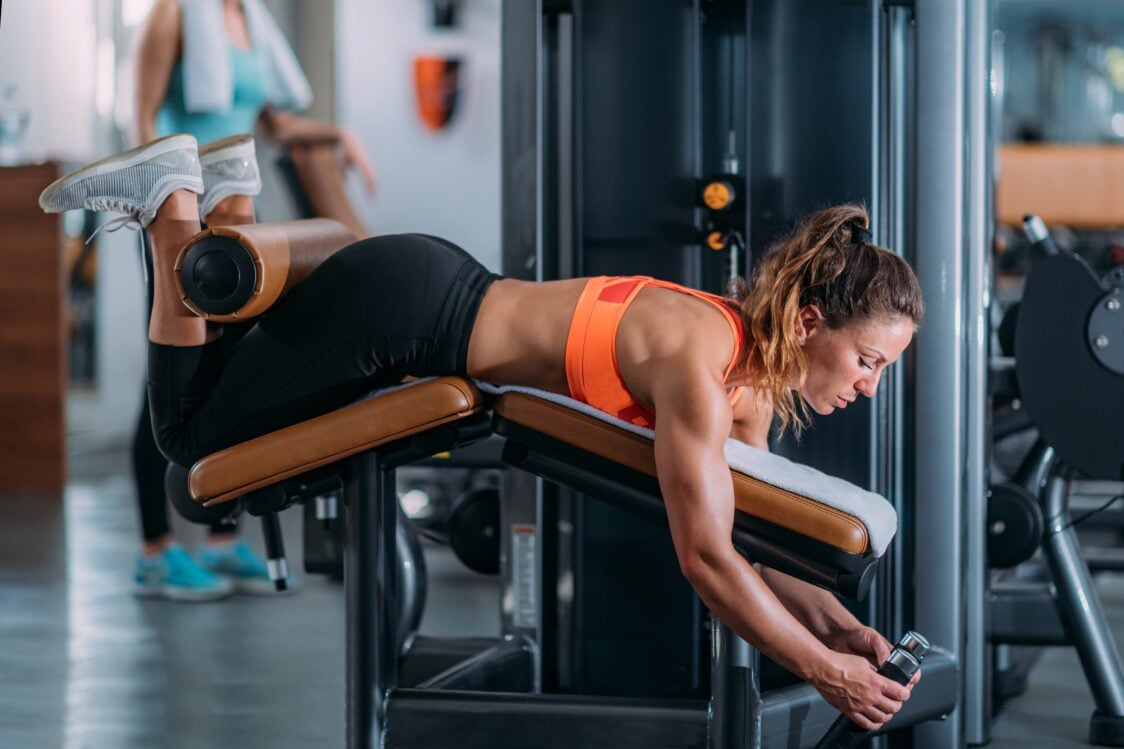
9 Most Effective Exercises for Thighs and Calves
With the listed exercises, you’ll effectively engage the major muscle groups of the thighs, including the musculus quadriceps femoris, commonly known as the quadriceps, the musculus biceps femoris or hamstring, and the inner thighs. The calf exercises will also naturally engage the musculus triceps surae, a three-headed muscle group in the calves.
These exercises are suitable for the gym, but if you have a barbell with plates, dumbbells, kettlebell, or even a powerbag at home, you can easily perform them in the comfort of your own home.
During each exercise, pay close attention to proper form and engage your core. If you aim to support knee stability, consider using neoprene wraps on them. For challenging squats or deadlifts, a weightlifting belt can be beneficial to strengthen your core and lower back.
You might be interested in these products:
1. Smith Machine Back Squat
- Starting Position: Adjust the barbell to a suitable height (below shoulder level) and load it with plates according to your strength capabilities. Stand under the barbell with your feet roughly shoulder-width apart. Place the barbell behind your neck and grip it with both hands beside your shoulders, ensuring that your elbows point downward. Release the safety hooks by rotating the bar.
- Execution: Inhale and initiate the squat by moving your hips backward and downward. Choose a squat depth that allows you to maintain the natural curvature of your spine and enables you to get up from this position. Keep the alignment of your knee, ankle, and toe in the same plane. Exhale and smoothly straighten up by activating the muscles of your buttocks and the front of your thighs. Perform additional repetitions in this manner. After completing the set, return the barbell back to the rack.
- Common Mistakes: Arching the back, limited range of motion, leaning forward, knees collapsing inward, uneven weight distribution, shifting onto the toes or heels, excessive or insufficient weight on the barbell.
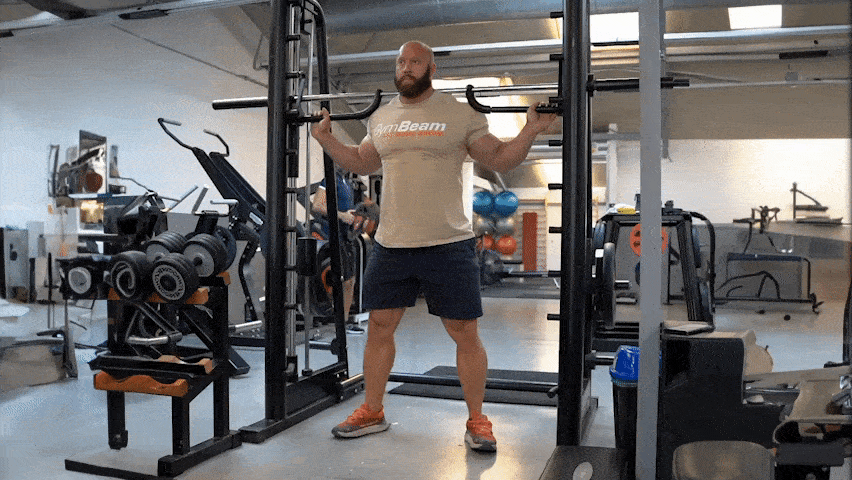
Other variations of the exercise:
1. Barbell Back Squat
You can also perform squats with a barbell on a regular rack or with a powerbag.
2. Goblet Squat
If you have access to a kettlebell or a dumbbell, you can try goblet squats. Hold the weight with both hands in front of your chest, and then proceed as with the basic version.
If you want to learn more about how to squat correctly, you shouldn’t miss our article: Squats: Benefits, Proper Execution and the Most Effective Variations for Both Home and the Gym
2. Hack Squat
- Starting Position: Load an appropriate weight on the hack squat machine. Stand on the platform with your feet roughly hip-width apart, lean your back against the backrest, and rest your shoulders on the designated supports. Grasp the handles with your hands and release the safety locks. Straighten your body, keeping your knees slightly bent.
- Execution: Inhale, perform a controlled squat, and then exhale as you return to the starting position by pushing your feet into the platform and raising. Proceed immediately with the next repetition.
- Common Mistakes: Limited range of motion, knees collapsing inward, excessive or insufficient weight load.

Other variations of the exercise:
1. Barbell Hack Squat
If you don’t have access to a hack squat machine, you can try performing hack squats using a barbell. Place a loaded barbell on the ground and stand with your back to it (the bar should rest against the lower part of your calves). Perform a squat, grip the barbell with your hands beside your body, then stand up. Perform another squat, allowing the plates to lightly touch the ground, and proceed immediately with the next repetition. Keep your back in a natural curve throughout.
Discover our bestsellers:
3. Leg Press
- Starting Position: Load up the leg press with an appropriate weight. Sit on the bench, lean against the backrest, and grab the handles beside you. Lift your legs, positioning your feet on the platform at hip-width. Get ready for the first repetition and release the safety locks.
- Execution: Slowly bend your knees, bringing the platform towards you. When your knees are nearly beside your chest, push through your feet into the platform as you exhale. Continue until your legs are almost fully extended. Be mindful to keep your back against the backrest. Proceed immediately with the next repetition.
- Common Mistakes: Limited range of motion, knees collapsing inward, lifting the back off the backrest, excessive or insufficient weight load.

4. Leg Extension
- Starting Position: Load up the machine with appropriate weight. Sit down, lean back, and hook your ankles behind the shin support roller. Adjust the roller’s height and position according to your preferences and the specific machine design. Grip the handles beside your body with your hands.
- Execution: Exhale and, with activating the muscles of the front thighs, extend your legs. At the top position, you can include a 1–2 second hold, then return to the starting position. Try to keep your back pressed against the support throughout the movement. Proceed immediately with the next repetition.
- Common Mistakes: Limited range of motion, arching the back, excessive or insufficient weight load.

5. Machine Lying Leg Curl
- Starting Position: Load up the machine with appropriate weight. Lie face down on the bench, and hook your feet around the support rollers, positioning them between your calves and heels. Adjust the rollers’ height and position according to your preferences and the specific machine design. Grip the handles with your hands.
- Execution: Exhale and, with activating the hamstrings, pull your heels toward your buttocks. In this position, you can include a 1–2 second hold, then return to the starting position. However, do not lock your knees when extending your legs. Proceed immediately with the next repetition. Keep your pelvis pressed against the support throughout the movement, and avoid arching your back.
- Common Mistakes: Limited range of motion, arching in the lower back (lumbar region), lifting the pelvis, excessive or insufficient weight load.
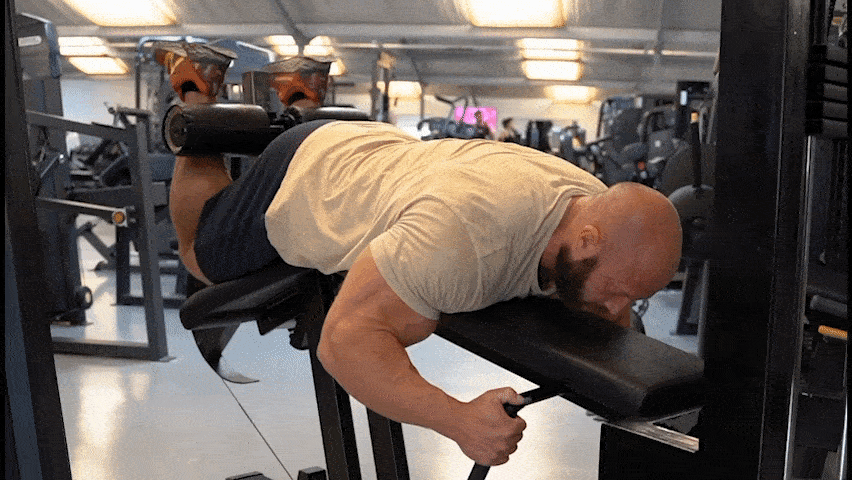
Other variations of the exercise:
1. Dumbell Lying Leg Curl
You can also perform this exercise without the need for a machine. Utilize a flat or an adjustable workout bench and a dumbbell. Position the dumbbell on the floor behind one end of the bench. Lie face down on the bench, gripping its edges with your hands, and hold the dumbbell between your feet. Exhale as you pull your feet toward your buttocks. If your pelvis starts to rise during the movement, consider placing a rolled towel or a smaller roller underneath for support.

6. Sumo Deadlift
- Starting Position: Stand in front of a barbell loaded with plates, placing your feet wider than shoulder-width apart. Ensure your toes and knees point outward. Bend your knees and lean forward toward the barbell, while maintaining the natural curvature of your back and keeping your head in line with your spine. Grip the barbell with both hands using either an overhand or alternating grip (one hand overhand, the other underhand). The grip width should be approximately shoulder-width or slightly narrower.
- Execution: Inhale and, as you exhale, gradually straighten up using the activation of the muscles in your thighs and buttocks. Begin by extending your knees and then smoothly straighten your torso. The barbell should travel upward close to your legs. Proceed immediately with the next repetition.
- Common Mistakes: Rounded back, uncontrolled movement, limited range of motion.

Other variations of the exercise:
1. Kettlebell Sumo Deadlift
You can also perform the sumo deadlift with two kettlebells. Place them on the ground next to each other between your feet. Your feet should be at a greater distance than the width of your shoulders, and your toes and knees should point outward. Then, grab both kettlebells and perform the exercise in the same way as with a barbell.
7. Machine Calf Raises
- Starting Position: Load up the machine with appropriate weight. Stand on the platform with your toes, ensuring that your heels extend beyond it. Rest your shoulders against the supports. Keep your body upright throughout the exercise.
- Execution: Using the contraction of your calves, lift your heels and press your entire body into the shoulder supports. When in this position, you can include a 1–2 second hold, then return to the starting position. Proceed immediately with the next repetition.
- Common Mistakes: Arching the back, limited range of motion, inappropriate weight load.
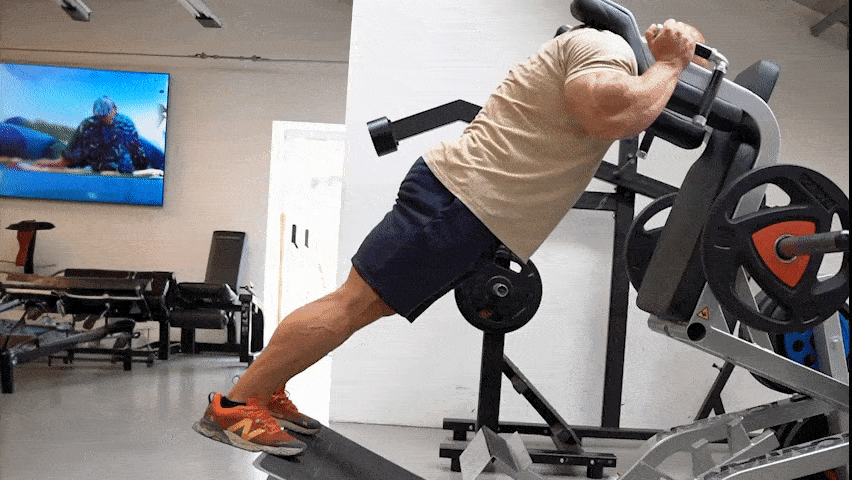
8. Dumbbell Calf Raises
- Starting Position: Sit on a bench with a straight back and your feet positioned approximately under your knees. Take two dumbbells and place them just above your knees, keeping them perpendicular to the ground. Keep a light grip on the dumbbells throughout the exercise.
- Execution: Lift your heels by contracting your calf muscles, and in the end position, you can include a 1–2 second hold. Then, return to the starting position in a controlled manner and proceed immediately with the next repetition. If you want to increase the range of motion, you can place a low step under the tips of your toes.
- Common Mistakes: Limited range of motion, inappropriate weight load.
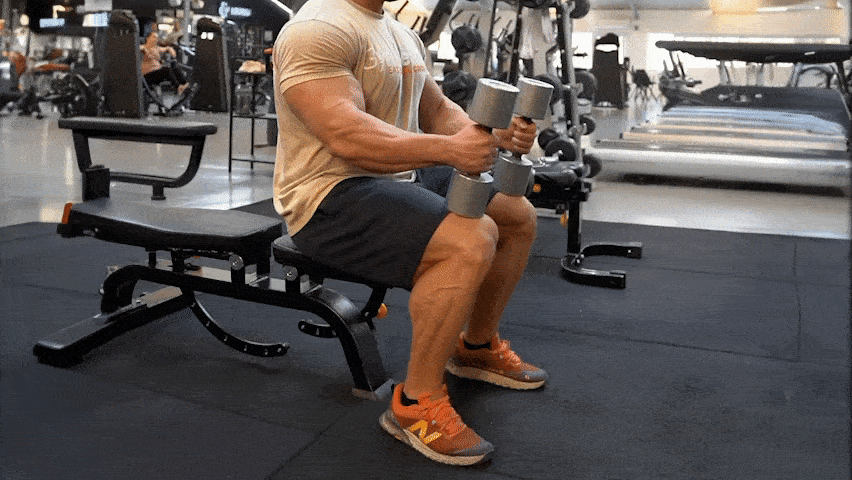
9. Barbell Calf Raises
- Starting Position: Adjust the barbell to an appropriate height (below shoulder level) and load it up with plates according to your strength capabilities. Stand under the barbell, grip it from the sides with both hands, and lift it off the rack. Take a step back.
- Execution: Lift your heels by contracting your calf muscles, and in the end position, you can include a 1–2 second hold. Then, return to the starting position in a controlled manner and proceed immediately with the next repetition.
- Common Mistakes: Limited range of motion, inappropriate weight load.
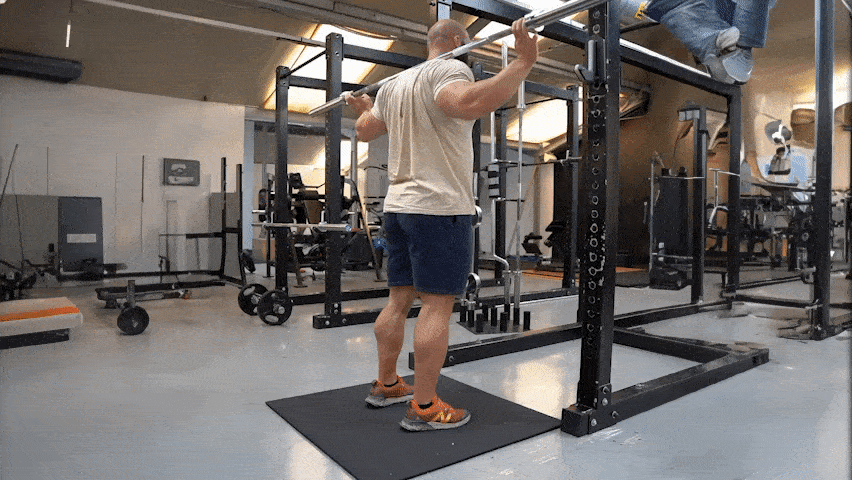
Where to Go From Here?
- You can find additional lower body exercises in the article: 9 Best Glutes & Legs Exercises
- You can create a workout for the upper body based on fitness articles for shoulders, back, chest, abs, biceps, and triceps.
- Are you interested in how to properly choose your workout weight load? You can learn more about it in the article: How Much Weight to Lift for Muscle Growth, Strength or Weight Loss?
- If you want to learn more about the ideal number of repetitions for an exercise based on your goals, read our article: How Many Reps Should You Do to Lose Weight or Gain Muscle?
- Are you trying to gain muscle mass but see no results? Then you shouldn’t miss our articles: 10 Tips for Healthy Weight Gain and What to Eat and How to Exercise to Finally Gain Muscle?
What Are the Main Takeaways?
If you are looking to get well-defined thighs and calves, incorporating exercises from today’s article into your workout routine is a wise choice. Different squat variations, deadlifts, leg extensions, and leg curls are ideal for working out the front, back, and inner sides of your thighs. Calf raises with a barbell or on a machine are essential for building strength and mass in the calves. However, always remember to pay attention to the proper technique during exercises, as it will yield the best results. Additionally, support your efforts with quality nutrition and adequate recovery.
Did you find this article helpful? If so, share it with your friends and inspire them with ideas for a thighs and calves workout.
[1] Burd, N. A., West, D. W. D., Moore, D. R., Atherton, P. J., Staples, A. W., Prior, T., Tang, J. E., Rennie, M. J., Baker, S. K., & Phillips, S. M. . Enhanced Amino Acid Sensitivity of Myofibrillar Protein Synthesis Persists for up to 24 h after Resistance Exercise in Young Men. – https://doi.org/10.3945/jn.110.135038
[2] Krzysztofik, M., Wil k, M., Wojdała, G., & Gołaś, A. Maximizing Muscle Hypertrophy: A Systematic Review of Advanced Resistance Training Techniques and Methods.– https://doi.org/10.3390/ijerph16244897
[3] Schoenfeld, B. J., Grgic, J., Van Every, D. W., & Plotkin, D. L. Loading Recommendations for Muscle Strength, Hypertrophy, and Local Endurance: A Re-Examination of the Repetition Continuum.– https://doi.org/10.3390/sports9020032


Add a comment